Remove engine ISUZU TROOPER 1998 Service Repair Manual
[x] Cancel search | Manufacturer: ISUZU, Model Year: 1998, Model line: TROOPER, Model: ISUZU TROOPER 1998Pages: 3573, PDF Size: 60.36 MB
Page 25 of 3573
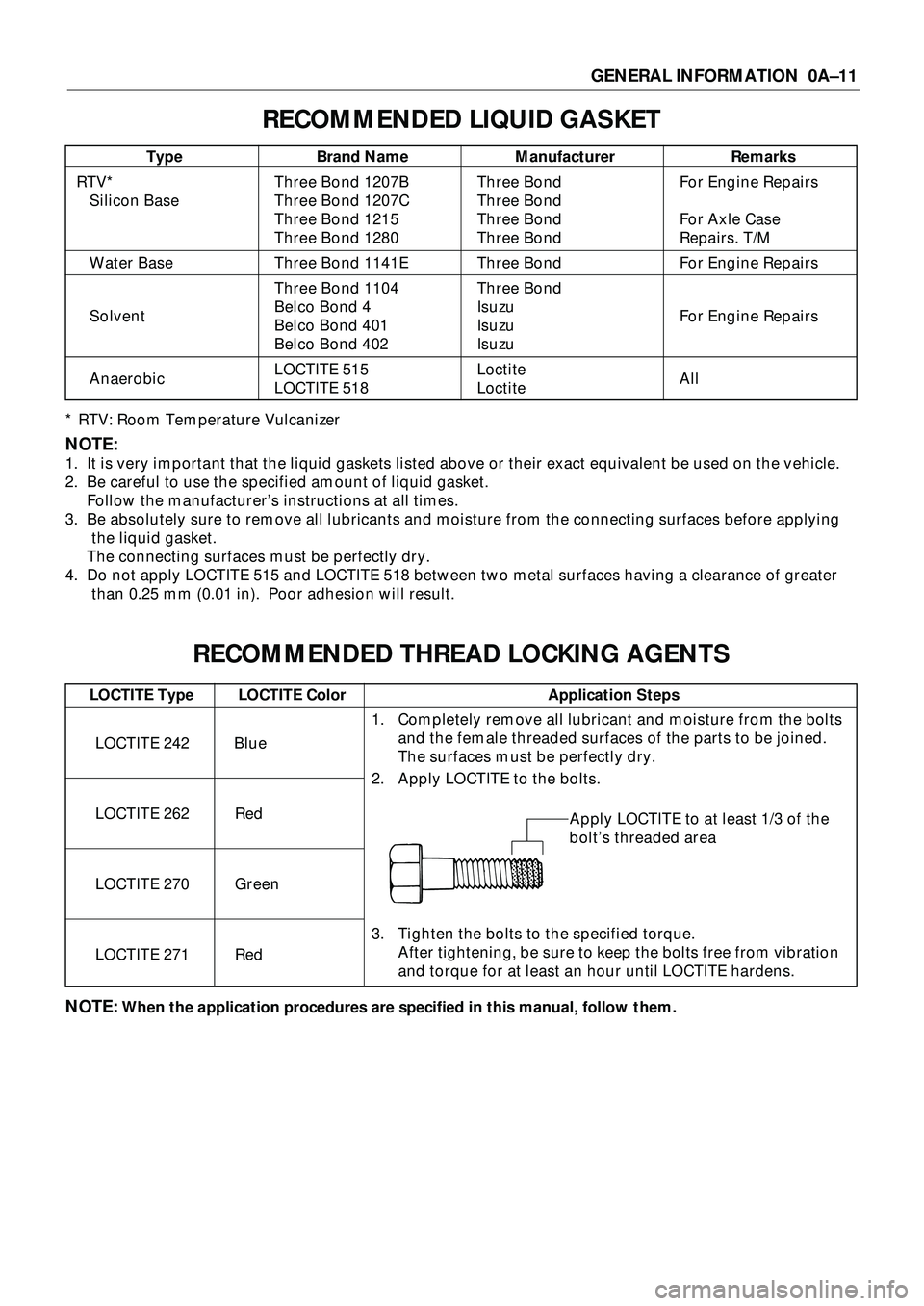
GENERAL INFORMATION 0AÐ11
RECOMMENDED LIQUID GASKET
* RTV: Room Temperature Vulcanizer
NOTE:
1. It is very important that the liquid gaskets listed above or their exact equivalent be used on the vehicle.
2. Be careful to use the specified amount of liquid gasket.
Follow the manufacturerÕs instructions at all times.
3. Be absolutely sure to remove all lubricants and moisture from the connecting surfaces before applying
the liquid gasket.
The connecting surfaces must be perfectly dry.
4. Do not apply LOCTITE 515 and LOCTITE 518 between two metal surfaces having a clearance of greater
than 0.25 mm (0.01 in). Poor adhesion will result.
RECOMMENDED THREAD LOCKING AGENTS
NOTE:When the application procedures are specified in this manual, follow them.
Type Brand Name Manufacturer Remarks
RTV* Three Bond 1207B Three Bond For Engine Repairs
Silicon Base Three Bond 1207C Three Bond
Three Bond 1215 Three Bond For Axle Case
Three Bond 1280 Three Bond Repairs. T/M
Water Base Three Bond 1141E Three Bond For Engine Repairs
Three Bond 1104 Three Bond
Belco Bond 4 Isuzu
Solvent
Belco Bond 401 Isuzu For Engine Repairs
Belco Bond 402 Isuzu
LOCTITE 515 Loctite
Anaerobic
LOCTITE 518 Loctite All
LOCTITE Type LOCTITE Color Application Steps
LOCTITE 242 Blue
LOCTITE 262 Red
LOCTITE 270 Green
LOCTITE 271 Red
1. Completely remove all lubricant and moisture from the bolts
and the female threaded surfaces of the parts to be joined.
The surfaces must be perfectly dry.
2. Apply LOCTITE to the bolts.
Apply LOCTITE to at least 1/3 of the
boltÕs threaded area
3. Tighten the bolts to the specified torque.
After tightening, be sure to keep the bolts free from vibration
and torque for at least an hour until LOCTITE hardens.
Page 67 of 3573
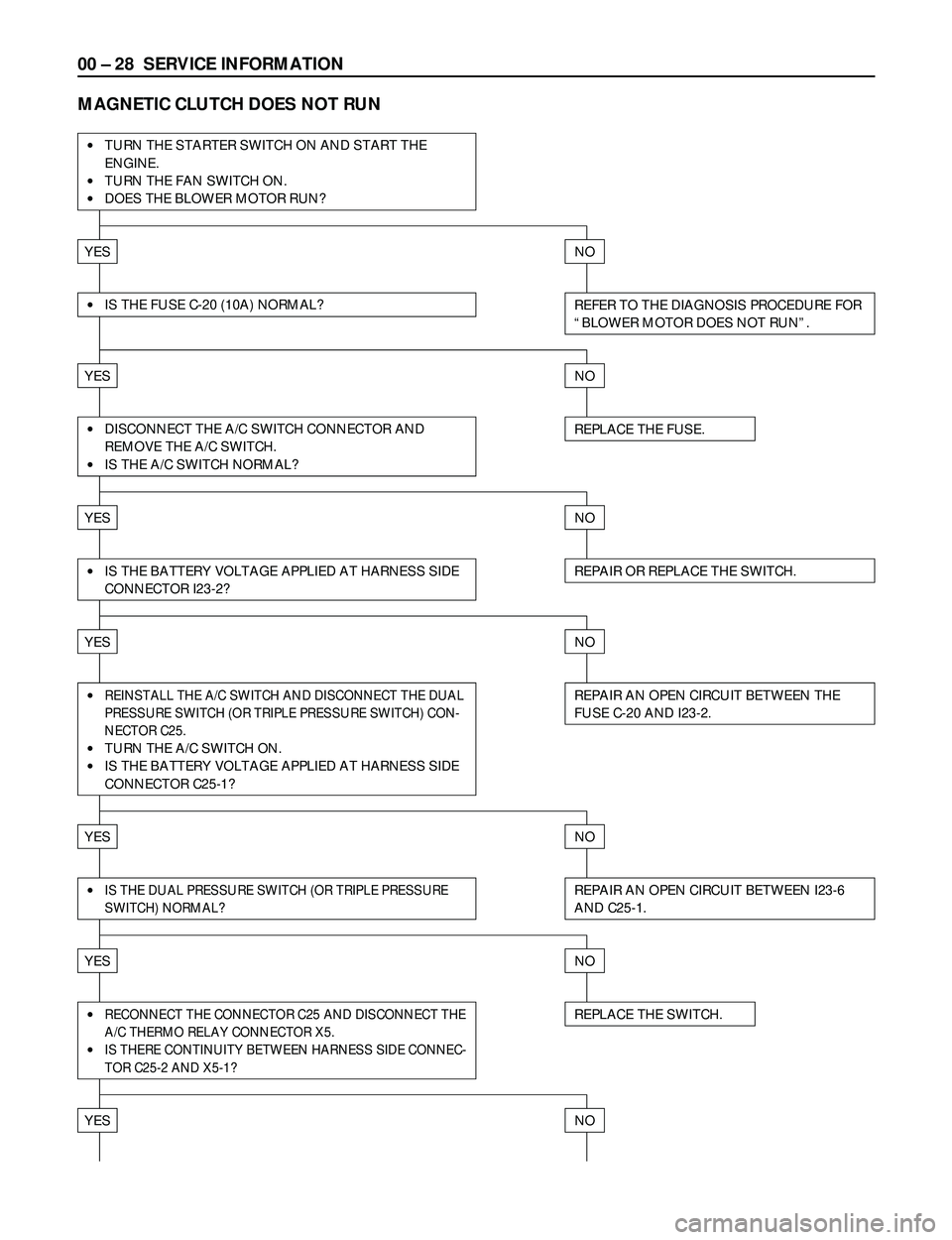
00 Ð 28 SERVICE INFORMATION
MAGNETIC CLUTCH DOES NOT RUN
·TURN THE STARTER SWITCH ON AND START THE
ENGINE.
·TURN THE FAN SWITCH ON.
·DOES THE BLOWER MOTOR RUN?
YESNO
REFER TO THE DIAGNOSIS PROCEDURE FOR
ÒBLOWER MOTOR DOES NOT RUNÓ.·IS THE FUSE C-20 (10A) NORMAL?
YESNO
REPLACE THE FUSE.·DISCONNECT THE A/C SWITCH CONNECTOR AND
REMOVE THE A/C SWITCH.
·IS THE A/C SWITCH NORMAL?
YESNO
YESNO
REPAIR AN OPEN CIRCUIT BETWEEN THE
FUSE C-20 AND I23-2.·REINSTALL THE A/C SWITCH AND DISCONNECT THE DUAL
PRESSURE SWITCH (OR TRIPLE PRESSURE SWITCH) CON-
NECTOR C25.
·TURN THE A/C SWITCH ON.
·IS THE BATTERY VOLTAGE APPLIED AT HARNESS SIDE
CONNECTOR C25-1?
YESNO
REPLACE THE SWITCH.·RECONNECT THE CONNECTOR C25 AND DISCONNECT THE
A/C THERMO RELAY CONNECTOR X5.
·IS THERE CONTINUITY BETWEEN HARNESS SIDE CONNEC-
TOR C25-2 AND X5-1?
YESNO
REPAIR AN OPEN CIRCUIT BETWEEN I23-6
AND C25-1.·IS THE DUAL PRESSURE SWITCH (OR TRIPLE PRESSURE
SWITCH) NORMAL?
YESNO
REPAIR OR REPLACE THE SWITCH.·IS THE BATTERY VOLTAGE APPLIED AT HARNESS SIDE
CONNECTOR I23-2?
Page 74 of 3573
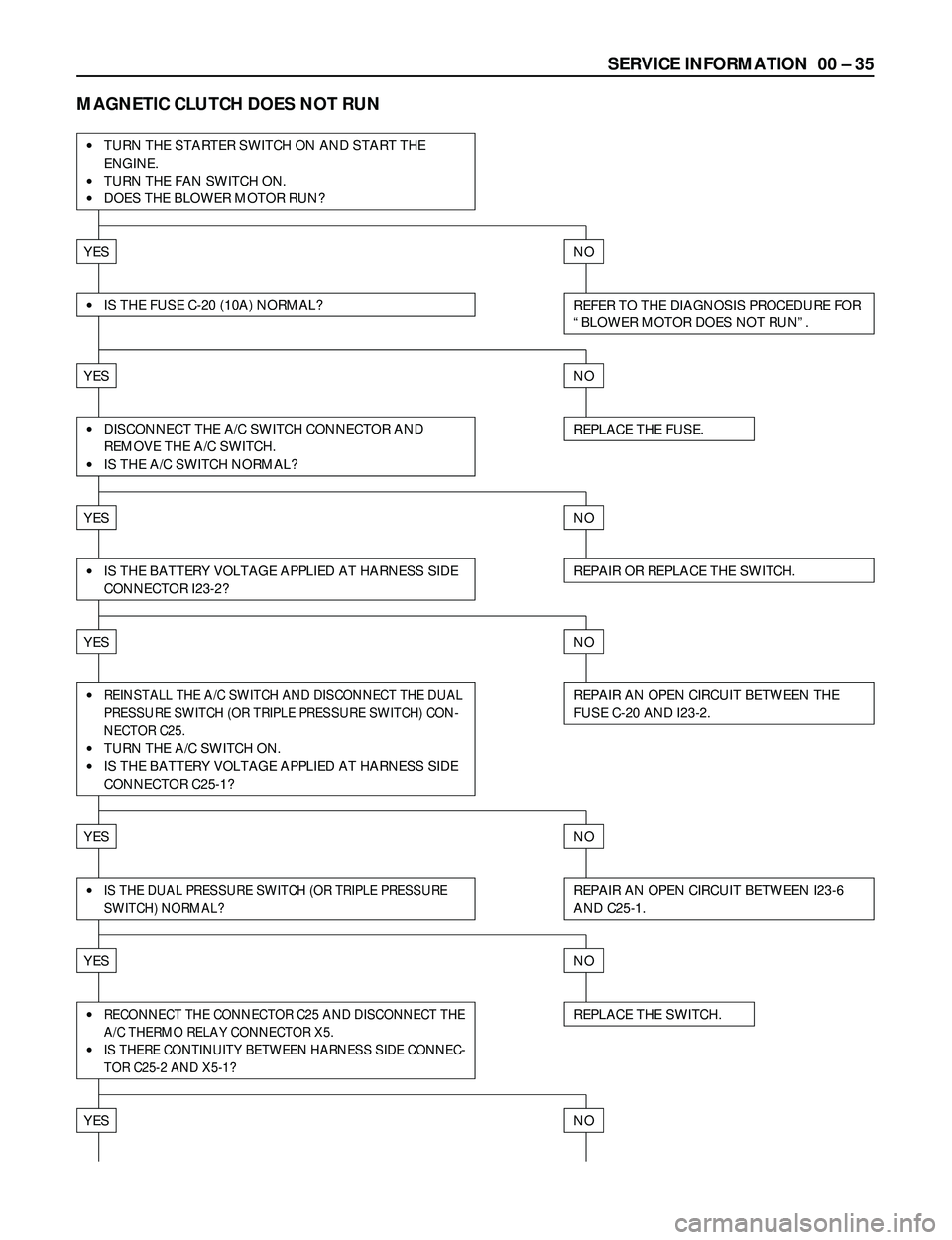
SERVICE INFORMATION 00 Ð 35
MAGNETIC CLUTCH DOES NOT RUN
·TURN THE STARTER SWITCH ON AND START THE
ENGINE.
·TURN THE FAN SWITCH ON.
·DOES THE BLOWER MOTOR RUN?
YESNO
REFER TO THE DIAGNOSIS PROCEDURE FOR
ÒBLOWER MOTOR DOES NOT RUNÓ.·IS THE FUSE C-20 (10A) NORMAL?
YESNO
REPLACE THE FUSE.·DISCONNECT THE A/C SWITCH CONNECTOR AND
REMOVE THE A/C SWITCH.
·IS THE A/C SWITCH NORMAL?
YESNO
YESNO
REPAIR AN OPEN CIRCUIT BETWEEN THE
FUSE C-20 AND I23-2.·REINSTALL THE A/C SWITCH AND DISCONNECT THE DUAL
PRESSURE SWITCH (OR TRIPLE PRESSURE SWITCH) CON-
NECTOR C25.
·TURN THE A/C SWITCH ON.
·IS THE BATTERY VOLTAGE APPLIED AT HARNESS SIDE
CONNECTOR C25-1?
YESNO
REPLACE THE SWITCH.·RECONNECT THE CONNECTOR C25 AND DISCONNECT THE
A/C THERMO RELAY CONNECTOR X5.
·IS THERE CONTINUITY BETWEEN HARNESS SIDE CONNEC-
TOR C25-2 AND X5-1?
YESNO
REPAIR AN OPEN CIRCUIT BETWEEN I23-6
AND C25-1.·IS THE DUAL PRESSURE SWITCH (OR TRIPLE PRESSURE
SWITCH) NORMAL?
YESNO
REPAIR OR REPLACE THE SWITCH.·IS THE BATTERY VOLTAGE APPLIED AT HARNESS SIDE
CONNECTOR I23-2?
Page 104 of 3573
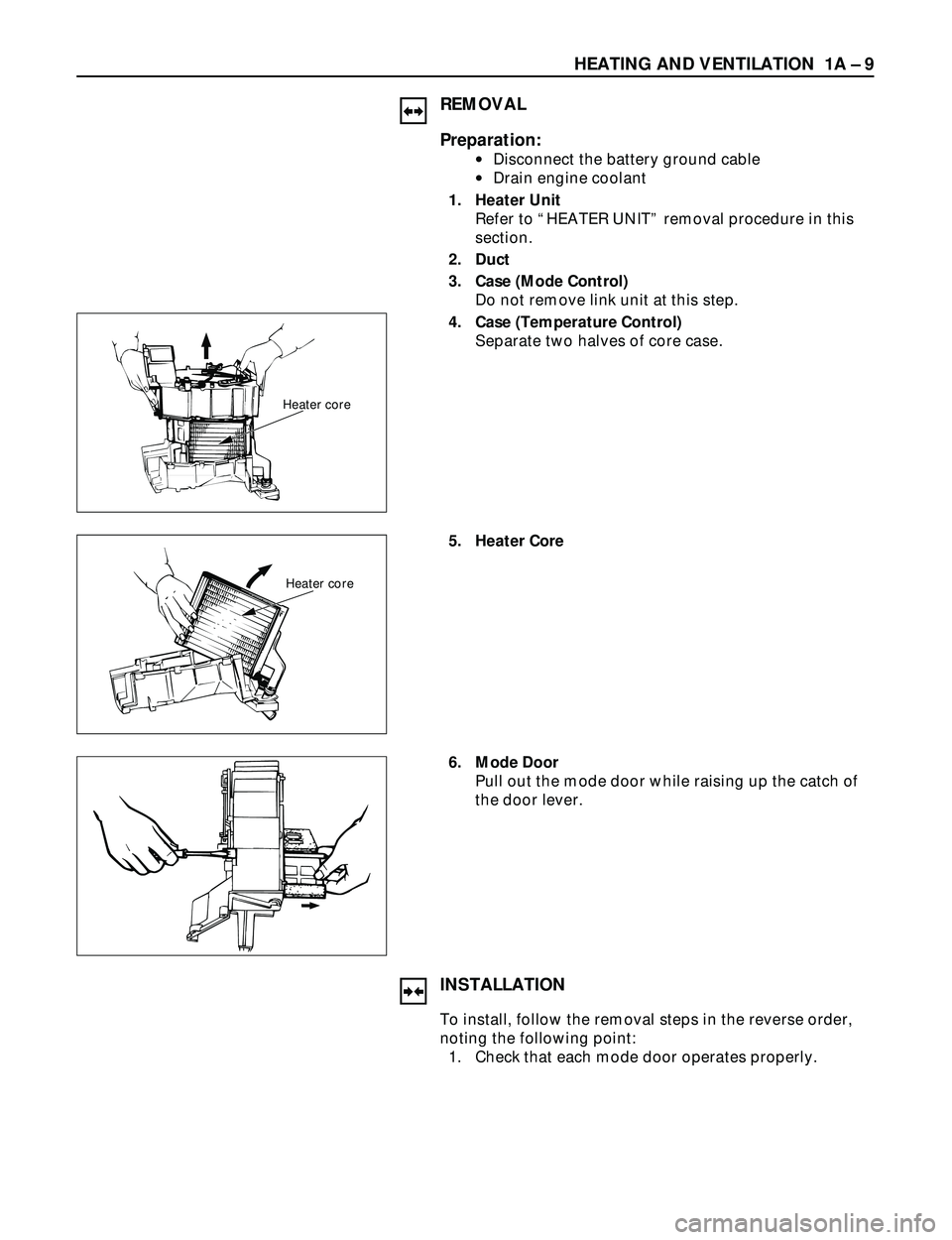
HEATING AND VENTILATION 1A Ð 9
REMOVAL
Preparation:
·Disconnect the battery ground cable
·Drain engine coolant
1. Heater Unit
Refer to ÒHEATER UNITÓ removal procedure in this
section.
2. Duct
3. Case (Mode Control)
Do not remove link unit at this step.
4. Case (Temperature Control)
Separate two halves of core case.
Heater core
5. Heater Core
Heater core
6. Mode Door
Pull out the mode door while raising up the catch of
the door lever.
INSTALLATION
To install, follow the removal steps in the reverse order,
noting the following point:
1. Check that each mode door operates properly.
Page 106 of 3573

HEATING AND VENTILATION 1A Ð 11
REMOVAL
Preparation:
·Disconnect the battery ground cable
·Drain engine coolant
1. Heater Unit
Refer to ÒHEATER UNITÓ removal procedure in this
section.
2. Case (Mode Control)
Remove the case (Mode control) from heater unit.
3. Washer and Mode Main Lever
4. Rod
5. Mode Sub-Lever
Press the tab of the sub-lever inward, and take out the
sub-lever.
6. Door Lever
Pull out the door lever while raising up the catch of
the door lever.
INSTALLATION
To install, follow the removal steps in the reverse order,
noting the following points:
1. Apply grease to mode sub-lever and to the abrasive
surface of the heater unit.
2. After installing the link unit, check to see if the link
unit operates correctly.
Page 108 of 3573

HEATING AND VENTILATION 1A Ð 13
REMOVAL
Preparation:
·Disconnect the battery ground cable
·Drain engine coolant
1. Heater Unit
Refer to ÒHEATER UNITÓ removal procedure in this
section.
2. Case (Temperature Control)
Remove the case (Temperature control) from the
heater unit.
3. Rod
4. Sub-Lever
5. Door Lever
Pull out the door lever while raising up the catch of
the door lever.
6. Clip
INSTALLATION
To install, follow the removal steps in the reverse order,
noting the following points:
1. Apply grease to sub-lever and to the abrasive surface
of the heater unit.
2. After installing the link unit, check to see if the link
unit operates correctly.
Page 130 of 3573
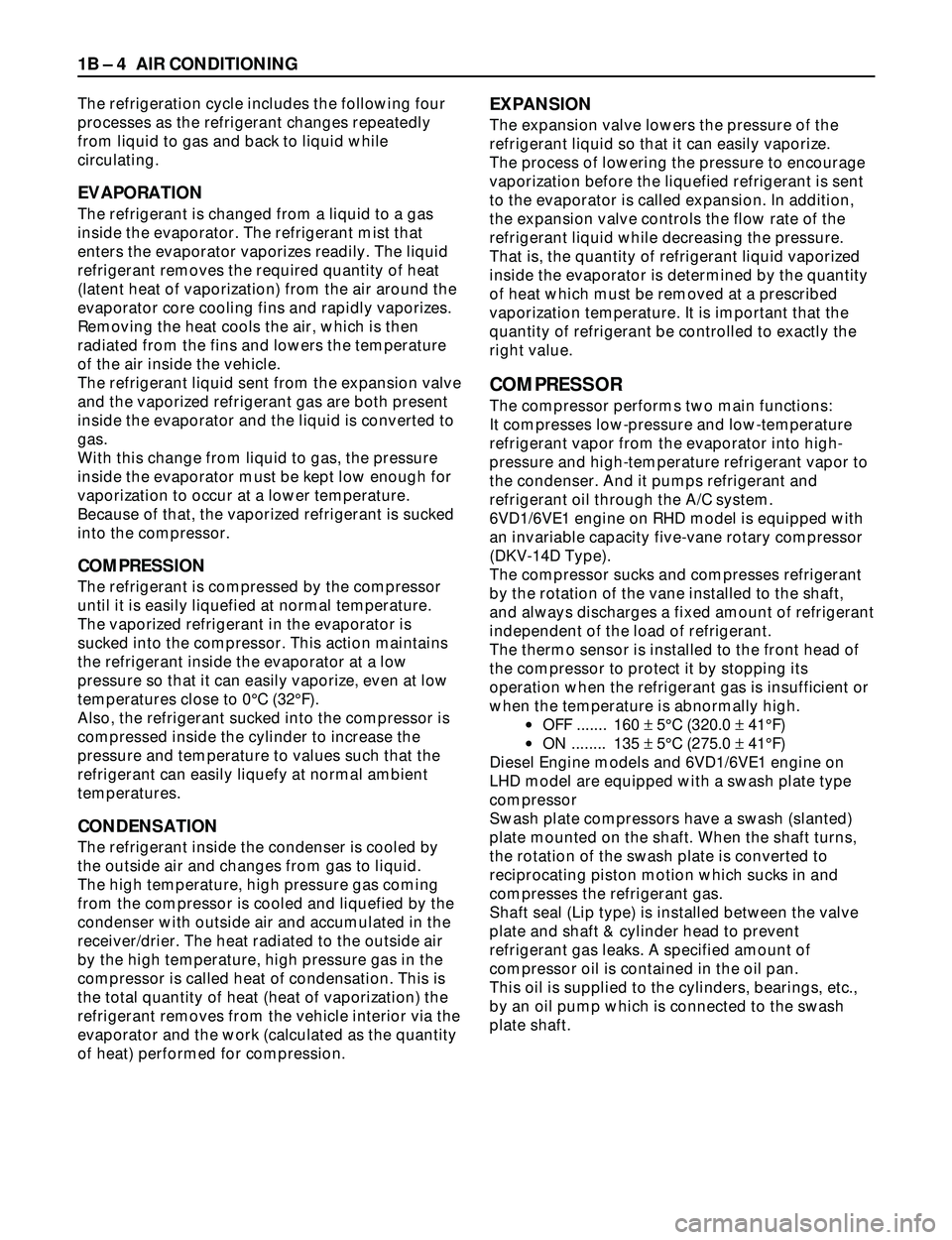
1B Ð 4 AIR CONDITIONING
The refrigeration cycle includes the following four
processes as the refrigerant changes repeatedly
from liquid to gas and back to liquid while
circulating.
EVAPORATION
The refrigerant is changed from a liquid to a gas
inside the evaporator. The refrigerant mist that
enters the evaporator vaporizes readily. The liquid
refrigerant removes the required quantity of heat
(latent heat of vaporization) from the air around the
evaporator core cooling fins and rapidly vaporizes.
Removing the heat cools the air, which is then
radiated from the fins and lowers the temperature
of the air inside the vehicle.
The refrigerant liquid sent from the expansion valve
and the vaporized refrigerant gas are both present
inside the evaporator and the liquid is converted to
gas.
With this change from liquid to gas, the pressure
inside the evaporator must be kept low enough for
vaporization to occur at a lower temperature.
Because of that, the vaporized refrigerant is sucked
into the compressor.
COMPRESSION
The refrigerant is compressed by the compressor
until it is easily liquefied at normal temperature.
The vaporized refrigerant in the evaporator is
sucked into the compressor. This action maintains
the refrigerant inside the evaporator at a low
pressure so that it can easily vaporize, even at low
temperatures close to 0¡C (32¡F).
Also, the refrigerant sucked into the compressor is
compressed inside the cylinder to increase the
pressure and temperature to values such that the
refrigerant can easily liquefy at normal ambient
temperatures.
CONDENSATION
The refrigerant inside the condenser is cooled by
the outside air and changes from gas to liquid.
The high temperature, high pressure gas coming
from the compressor is cooled and liquefied by the
condenser with outside air and accumulated in the
receiver/drier. The heat radiated to the outside air
by the high temperature, high pressure gas in the
compressor is called heat of condensation. This is
the total quantity of heat (heat of vaporization) the
refrigerant removes from the vehicle interior via the
evaporator and the work (calculated as the quantity
of heat) performed for compression.
EXPANSION
The expansion valve lowers the pressure of the
refrigerant liquid so that it can easily vaporize.
The process of lowering the pressure to encourage
vaporization before the liquefied refrigerant is sent
to the evaporator is called expansion. In addition,
the expansion valve controls the flow rate of the
refrigerant liquid while decreasing the pressure.
That is, the quantity of refrigerant liquid vaporized
inside the evaporator is determined by the quantity
of heat which must be removed at a prescribed
vaporization temperature. It is important that the
quantity of refrigerant be controlled to exactly the
right value.
COMPRESSOR
The compressor performs two main functions:
It compresses low-pressure and low-temperature
refrigerant vapor from the evaporator into high-
pressure and high-temperature refrigerant vapor to
the condenser. And it pumps refrigerant and
refrigerant oil through the A/C system.
6VD1/6VE1 engine on RHD model is equipped with
an invariable capacity five-vane rotary compressor
(DKV-14D Type).
The compressor sucks and compresses refrigerant
by the rotation of the vane installed to the shaft,
and always discharges a fixed amount of refrigerant
independent of the load of refrigerant.
The thermo sensor is installed to the front head of
the compressor to protect it by stopping its
operation when the refrigerant gas is insufficient or
when the temperature is abnormally high.
·OFF ....... 160 ±5¡C (320.0 ±41¡F)
·ON ........ 135 ±5¡C (275.0 ±41¡F)
Diesel Engine models and 6VD1/6VE1 engine on
LHD model are equipped with a swash plate type
compressor
Swash plate compressors have a swash (slanted)
plate mounted on the shaft. When the shaft turns,
the rotation of the swash plate is converted to
reciprocating piston motion which sucks in and
compresses the refrigerant gas.
Shaft seal (Lip type) is installed between the valve
plate and shaft & cylinder head to prevent
refrigerant gas leaks. A specified amount of
compressor oil is contained in the oil pan.
This oil is supplied to the cylinders, bearings, etc.,
by an oil pump which is connected to the swash
plate shaft.
Page 131 of 3573
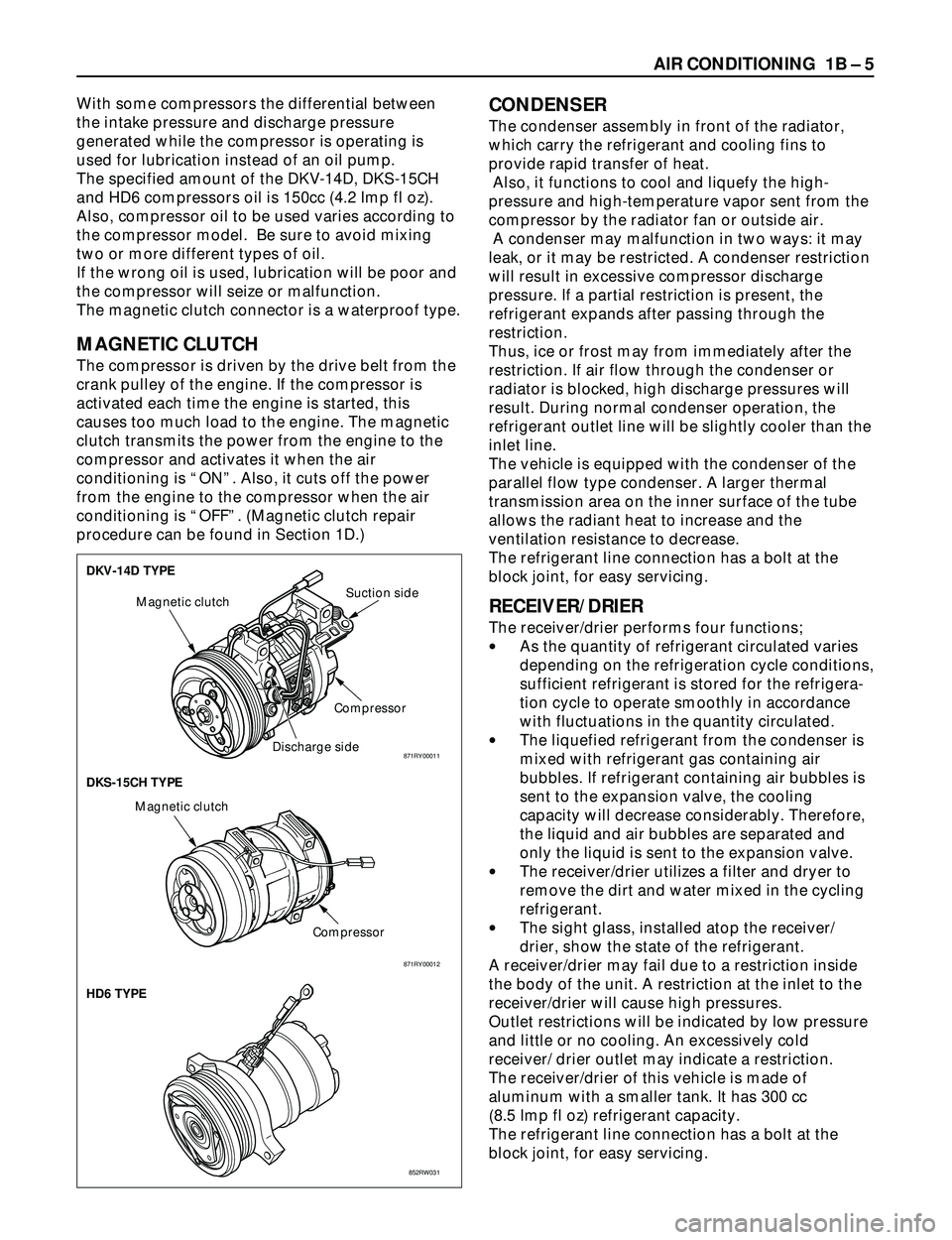
AIR CONDITIONING 1B Ð 5
With some compressors the differential between
the intake pressure and discharge pressure
generated while the compressor is operating is
used for lubrication instead of an oil pump.
The specified amount of the DKV-14D, DKS-15CH
and HD6 compressors oil is 150cc (4.2 Imp fl oz).
Also, compressor oil to be used varies according to
the compressor model. Be sure to avoid mixing
two or more different types of oil.
If the wrong oil is used, lubrication will be poor and
the compressor will seize or malfunction.
The magnetic clutch connector is a waterproof type.
MAGNETIC CLUTCH
The compressor is driven by the drive belt from the
crank pulley of the engine. If the compressor is
activated each time the engine is started, this
causes too much load to the engine. The magnetic
clutch transmits the power from the engine to the
compressor and activates it when the air
conditioning is ÒONÓ. Also, it cuts off the power
from the engine to the compressor when the air
conditioning is ÒOFFÓ. (Magnetic clutch repair
procedure can be found in Section 1D.)
CONDENSER
The condenser assembly in front of the radiator,
which carry the refrigerant and cooling fins to
provide rapid transfer of heat.
Also, it functions to cool and liquefy the high-
pressure and high-temperature vapor sent from the
compressor by the radiator fan or outside air.
A condenser may malfunction in two ways: it may
leak, or it may be restricted. A condenser restriction
will result in excessive compressor discharge
pressure. If a partial restriction is present, the
refrigerant expands after passing through the
restriction.
Thus, ice or frost may from immediately after the
restriction. If air flow through the condenser or
radiator is blocked, high discharge pressures will
result. During normal condenser operation, the
refrigerant outlet line will be slightly cooler than the
inlet line.
The vehicle is equipped with the condenser of the
parallel flow type condenser. A larger thermal
transmission area on the inner surface of the tube
allows the radiant heat to increase and the
ventilation resistance to decrease.
The refrigerant line connection has a bolt at the
block joint, for easy servicing.
RECEIVER/DRIER
The receiver/drier performs four functions;
·As the quantity of refrigerant circulated varies
depending on the refrigeration cycle conditions,
sufficient refrigerant is stored for the refrigera-
tion cycle to operate smoothly in accordance
with fluctuations in the quantity circulated.
·The liquefied refrigerant from the condenser is
mixed with refrigerant gas containing air
bubbles. If refrigerant containing air bubbles is
sent to the expansion valve, the cooling
capacity will decrease considerably. Therefore,
the liquid and air bubbles are separated and
only the liquid is sent to the expansion valve.
·The receiver/drier utilizes a filter and dryer to
remove the dirt and water mixed in the cycling
refrigerant.
·The sight glass, installed atop the receiver/
drier, show the state of the refrigerant.
A receiver/drier may fail due to a restriction inside
the body of the unit. A restriction at the inlet to the
receiver/drier will cause high pressures.
Outlet restrictions will be indicated by low pressure
and little or no cooling. An excessively cold
receiver/ drier outlet may indicate a restriction.
The receiver/drier of this vehicle is made of
aluminum with a smaller tank. It has 300 cc
(8.5 Imp fl oz) refrigerant capacity.
The refrigerant line connection has a bolt at the
block joint, for easy servicing.
DKV-14D TYPE
DKS-15CH TYPE
HD6 TYPE
Magnetic clutch
CompressorSuction side
Discharge side
Compressor Magnetic clutch
852RW031 871RY00012
871RY00011
Page 139 of 3573
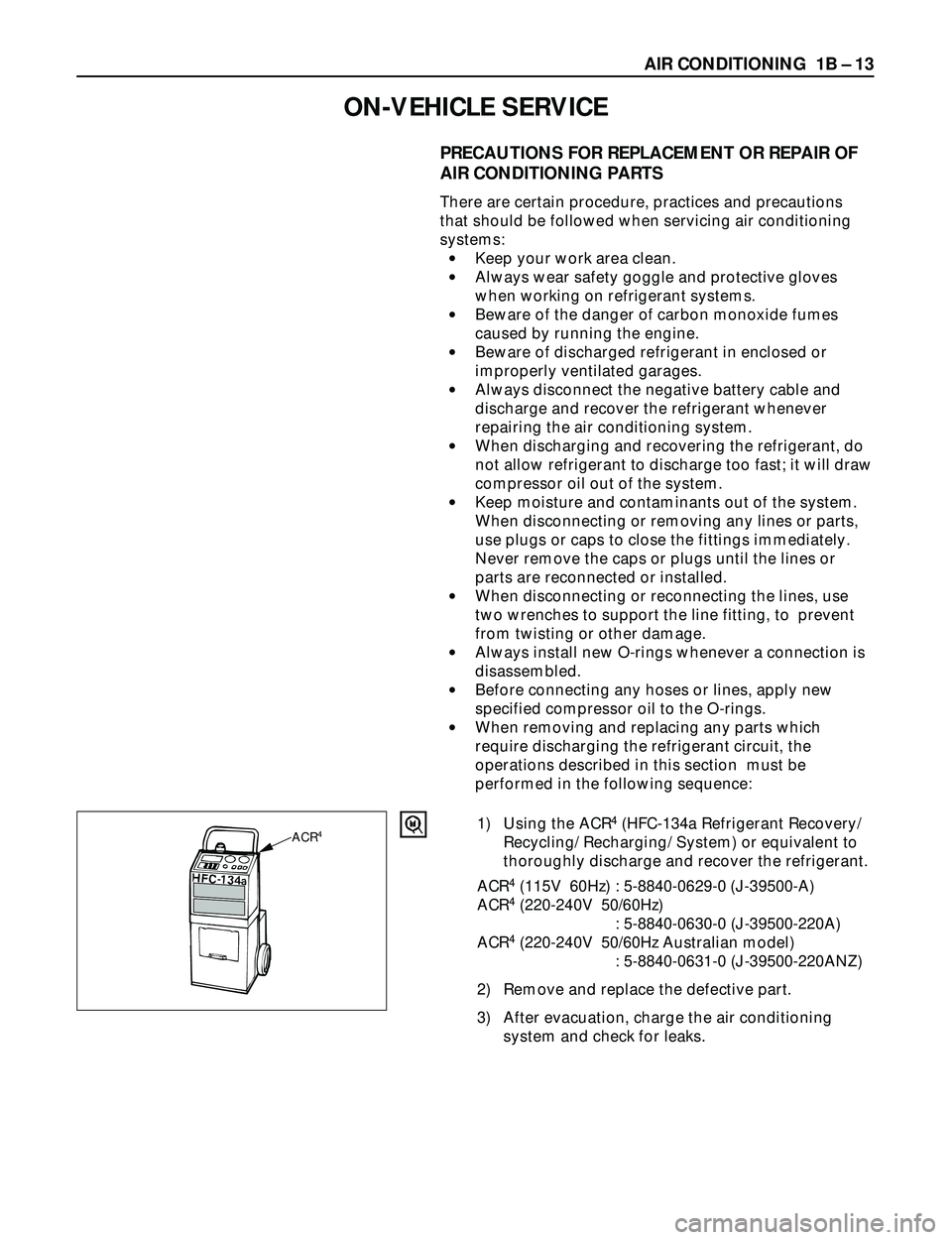
AIR CONDITIONING 1B Ð 13
ACR41) Using the ACR4(HFC-134a Refrigerant Recovery/
Recycling/ Recharging/ System) or equivalent to
thoroughly discharge and recover the refrigerant.
ACR
4(115V 60Hz) : 5-8840-0629-0 (J-39500-A)
ACR4(220-240V 50/60Hz)
: 5-8840-0630-0 (J-39500-220A)
ACR
4(220-240V 50/60Hz Australian model)
: 5-8840-0631-0 (J-39500-220ANZ)
2) Remove and replace the defective part.
3) After evacuation, charge the air conditioning
system and check for leaks.
PRECAUTIONS FOR REPLACEMENT OR REPAIR OF
AIR CONDITIONING PARTS
There are certain procedure, practices and precautions
that should be followed when servicing air conditioning
systems:
·Keep your work area clean.
·Always wear safety goggle and protective gloves
when working on refrigerant systems.
·Beware of the danger of carbon monoxide fumes
caused by running the engine.
·Beware of discharged refrigerant in enclosed or
improperly ventilated garages.
·Always disconnect the negative battery cable and
discharge and recover the refrigerant whenever
repairing the air conditioning system.
·When discharging and recovering the refrigerant, do
not allow refrigerant to discharge too fast; it will draw
compressor oil out of the system.
·Keep moisture and contaminants out of the system.
When disconnecting or removing any lines or parts,
use plugs or caps to close the fittings immediately.
Never remove the caps or plugs until the lines or
parts are reconnected or installed.
·When disconnecting or reconnecting the lines, use
two wrenches to support the line fitting, to prevent
from twisting or other damage.
·Always install new O-rings whenever a connection is
disassembled.
·Before connecting any hoses or lines, apply new
specified compressor oil to the O-rings.
·When removing and replacing any parts which
require discharging the refrigerant circuit, the
operations described in this section must be
performed in the following sequence:
ON-VEHICLE SERVICE
Page 146 of 3573
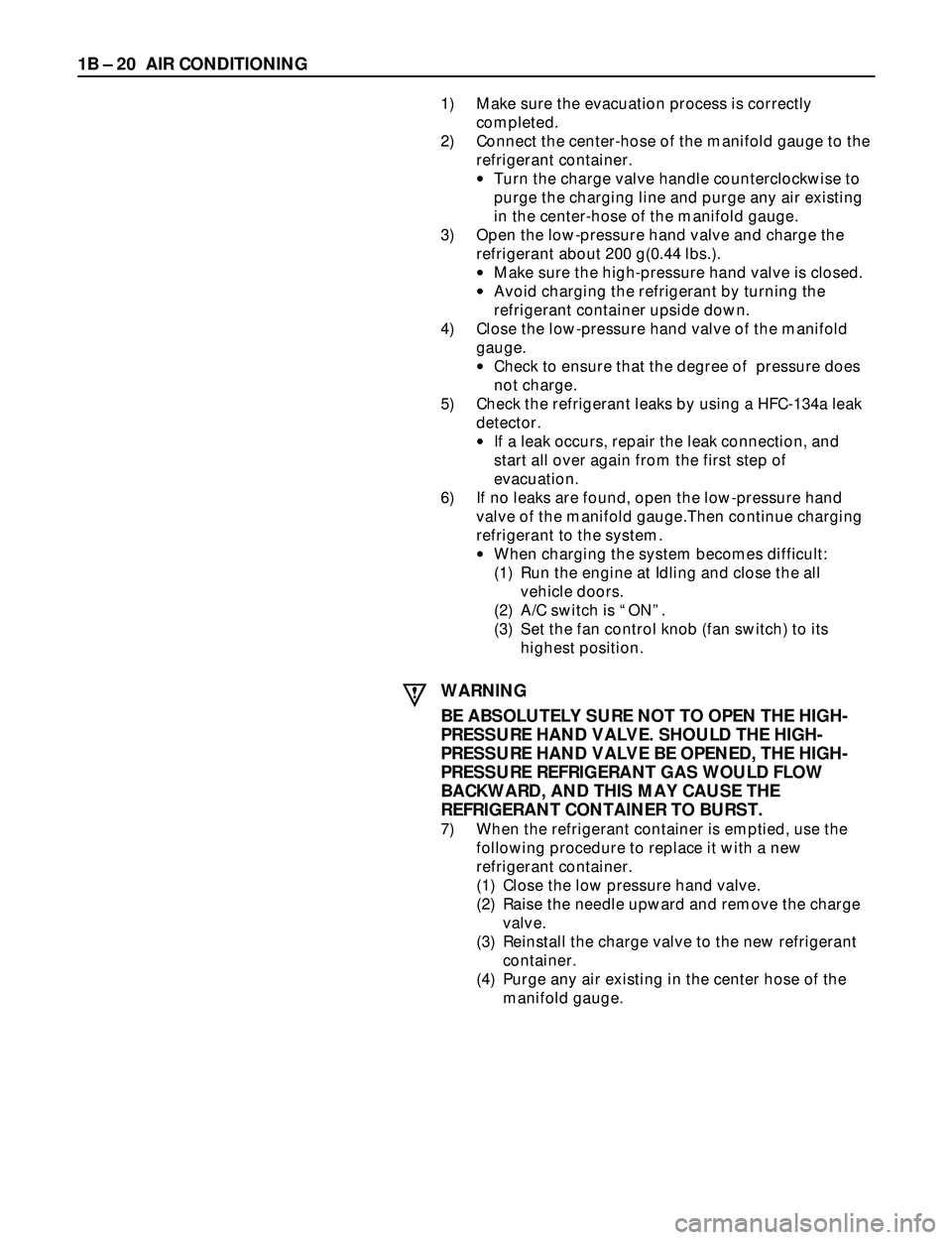
1B Ð 20 AIR CONDITIONING
1) Make sure the evacuation process is correctly
completed.
2) Connect the center-hose of the manifold gauge to the
refrigerant container.
·Turn the charge valve handle counterclockwise to
purge the charging line and purge any air existing
in the center-hose of the manifold gauge.
3) Open the low-pressure hand valve and charge the
refrigerant about 200 g(0.44 lbs.).
·Make sure the high-pressure hand valve is closed.
·Avoid charging the refrigerant by turning the
refrigerant container upside down.
4) Close the low-pressure hand valve of the manifold
gauge.
·Check to ensure that the degree of pressure does
not charge.
5) Check the refrigerant leaks by using a HFC-134a leak
detector.
·If a leak occurs, repair the leak connection, and
start all over again from the first step of
evacuation.
6) If no leaks are found, open the low-pressure hand
valve of the manifold gauge.Then continue charging
refrigerant to the system.
·When charging the system becomes difficult:
(1) Run the engine at Idling and close the all
vehicle doors.
(2) A/C switch is ÒONÓ.
(3) Set the fan control knob (fan switch) to its
highest position.
WARNING
BE ABSOLUTELY SURE NOT TO OPEN THE HIGH-
PRESSURE HAND VALVE. SHOULD THE HIGH-
PRESSURE HAND VALVE BE OPENED, THE HIGH-
PRESSURE REFRIGERANT GAS WOULD FLOW
BACKWARD, AND THIS MAY CAUSE THE
REFRIGERANT CONTAINER TO BURST.
7) When the refrigerant container is emptied, use the
following procedure to replace it with a new
refrigerant container.
(1) Close the low pressure hand valve.
(2) Raise the needle upward and remove the charge
valve.
(3) Reinstall the charge valve to the new refrigerant
container.
(4) Purge any air existing in the center hose of the
manifold gauge.